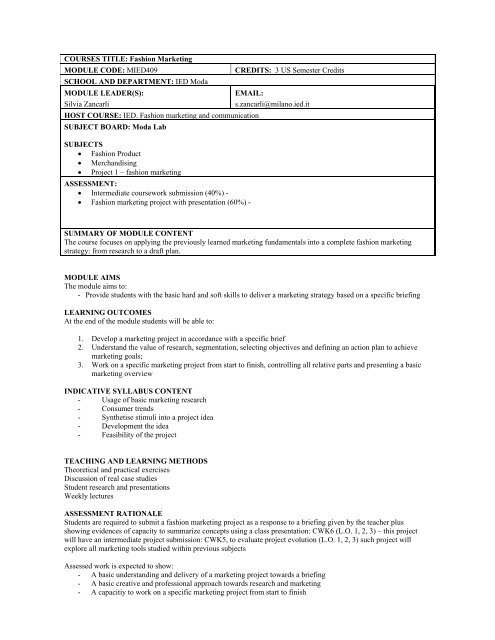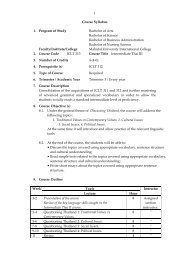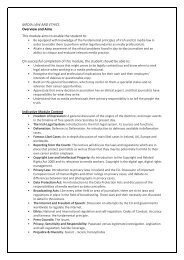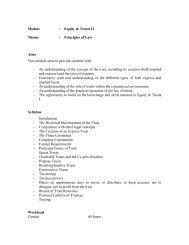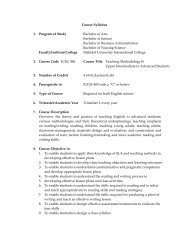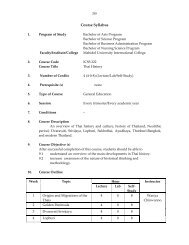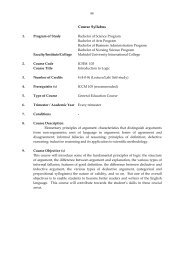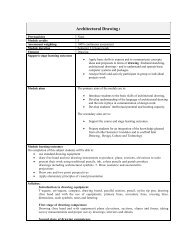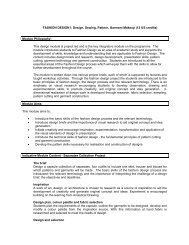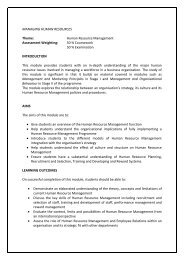COURSES TITLE: Fashion Marketing MODULE CODE ... - KEI
COURSES TITLE: Fashion Marketing MODULE CODE ... - KEI
COURSES TITLE: Fashion Marketing MODULE CODE ... - KEI
You also want an ePaper? Increase the reach of your titles
YUMPU automatically turns print PDFs into web optimized ePapers that Google loves.
<strong>COURSES</strong> <strong>TITLE</strong>: <strong>Fashion</strong> <strong>Marketing</strong><br />
<strong>MODULE</strong> <strong>CODE</strong>: MIED409 CREDITS: 3 US Semester Credits<br />
SCHOOL AND DEPARTMENT: IED Moda<br />
<strong>MODULE</strong> LEADER(S):<br />
Silvia Zancarli<br />
HOST COURSE: IED. <strong>Fashion</strong> marketing and communication<br />
SUBJECT BOARD: Moda Lab<br />
SUBJECTS<br />
<strong>Fashion</strong> Product<br />
Merchandising<br />
Project 1 – fashion marketing<br />
ASSESSMENT:<br />
Intermediate coursework submission (40%) -<br />
<strong>Fashion</strong> marketing project with presentation (60%) -<br />
EMAIL:<br />
s.zancarli@milano.ied.it<br />
SUMMARY OF <strong>MODULE</strong> CONTENT<br />
The course focuses on applying the previously learned marketing fundamentals into a complete fashion marketing<br />
strategy: from research to a draft plan.<br />
<strong>MODULE</strong> AIMS<br />
The module aims to:<br />
- Provide students with the basic hard and soft skills to deliver a marketing strategy based on a specific briefing<br />
LEARNING OUTCOMES<br />
At the end of the module students will be able to:<br />
1. Develop a marketing project in accordance with a specific brief<br />
2. Understand the value of research, segmentation, selecting objectives and defining an action plan to achieve<br />
marketing goals;<br />
3. Work on a specific marketing project from start to finish, controlling all relative parts and presenting a basic<br />
marketing overview<br />
INDICATIVE SYLLABUS CONTENT<br />
- Usage of basic marketing research<br />
- Consumer trends<br />
- Synthetise stimuli into a project idea<br />
- Development the idea<br />
- Feasibility of the project<br />
TEACHING AND LEARNING METHODS<br />
Theoretical and practical exercises<br />
Discussion of real case studies<br />
Student research and presentations<br />
Weekly lectures<br />
ASSESSMENT RATIONALE<br />
Students are required to submit a fashion marketing project as a response to a briefing given by the teacher plus<br />
showing evidences of capacity to summarize concepts using a class presentation: CWK6 (L.O. 1, 2, 3) – this project<br />
will have an intermediate project submission: CWK5, to evaluate project evolution (L.O. 1, 2, 3) such project will<br />
explore all marketing tools studied within previous subjects<br />
Assessed work is expected to show:<br />
- A basic understanding and delivery of a marketing project towards a briefing<br />
- A basic creative and professional approach towards research and marketing<br />
- A capacitiy to work on a specific marketing project from start to finish
- A basic ability to work in record project execution to evaluate work in progress performance<br />
- Individual presentation skills;<br />
SOURCES<br />
Essential Reading<br />
R. Patrick Cash, Chris Thomas, John W. Wingate, Joseph S. Friedlander. Management of retail buying– Ed. John Wiley<br />
& Sons Inc., 2006 (Hobokey, NJ, USA)<br />
Davis Burns L., Bryant N.O., The Business of <strong>Fashion</strong>, Designing, Manufacturing and <strong>Marketing</strong>, Fairchild, 3rd ed.<br />
2007 Balestri A., Ricchetti M., The Rationality of the <strong>Fashion</strong> Machine, in: Malossi G. (ed.), 1998<br />
Thomas, D., Deluxe: How luxury lost its luster, The Penguin Press, 2007<br />
D.H. Kincade, F.Y. Gibson, Merchandising of <strong>Fashion</strong> Products, Prentice Hall 2009 Easey, M., <strong>Fashion</strong> <strong>Marketing</strong>,<br />
Wiley Blackwell, 2010<br />
Additional References<br />
Agins T., The End of <strong>Fashion</strong>, How <strong>Marketing</strong> Changed the Clothing Business Forever, Harper&Collins Publishers,<br />
1999<br />
Balestri A., Ricchetti M., The Rationality of the <strong>Fashion</strong> Machine, in: Malossi G. (ed.), 1998<br />
Black S., Eco-Chic, The <strong>Fashion</strong> Paradox, Black Dog Publishing, 2008<br />
Brown S., Turley D., Consumer Research: Postcards from the Edge, Routledge 1997 Caves R.E, Creative Industries:<br />
Contracts Between Art and Commerce (ch. Introduction, ch.11, 12), Harvard University Press, 2000<br />
Davis Burns L., Bryant N.O., The Business of <strong>Fashion</strong>, Designing, Manufacturing and <strong>Marketing</strong>, Fairchild, 3rd ed.<br />
2007<br />
Foot J., Milan Since the Miracle, City, Culture, Identity, Berg Publishers, 2001<br />
Frey N., How to do it, Interview to Paul Smith, in G. Malossi (ed.), 1998<br />
“<strong>Fashion</strong> Buying&Merchandising Management”, T. Jackson, D. Shaw, Palgrave M.S. 2001<br />
R. Patrick Cash, Chris Thomas, John W. Wingate, Joseph S. Friedlander – “Management of retail buying” – Ed. John<br />
Wiley & Sons Inc., 2006 (Hobokey, NJ, USA)


